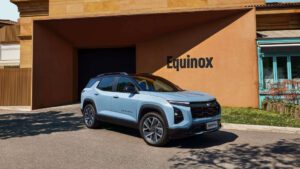2023 Subaru Solterra: EV Meets ORV

The 2023 Subaru Solterra doesn’t have 500 horsepower or 300 miles of range. It can’t recharge in 15 minutes or power your house as a backup generator. There’s no frunk, and it won’t bowl you over with outrageous specs or design. We’d consider it a homework assignment turned in late were it not for its off-road acumen, which makes it rather unique among mainstream EVs. Sure, you can ice your shrimp in the frunk of a Ford Mustang Mach-E, and you can power your fridge with a Kia EV6. But you wouldn’t want to take either of those crossovers too far off the beaten path. The Solterra, on the other hand, is like most Subarus: game for some trail work. It’s only a matter of time before we start seeing them treated to the official Crosstrek Starter Kit, donning a two-inch suspension lift and a set of BFGoodrich KO2s.
As with its BRZ coupe, Subaru jointly developed the Solterra with Toyota, which has a counterpart catchily named bZ4x. But the Solterra and bZ4x diverge more than the BRZ and its Toyota GR86 twin, most notably in the fact that the Solterra is only offered with all-wheel drive, which is consistent with the Subaru ethos; the bZ4x offers a lesser front-wheel-drive variant. With 8.3 inches of ground clearance, decent approach and departure angles, and 19.7 inches of water-fording ability, the Solterra should be happy enough to haul your mountain bikes to the trailhead. Or get your kayak to the put-in, or schlep your big goofy mutt to that dog park that’s accessible only via a rutted forest road. You won’t want to get too carried away, but we took it on some Arizona ORV trails and it acquitted itself surprisingly well, scrambling up inclines steep enough that you had to use the forward-looking camera to see over blind crests.
Like Subaru’s rugged Wilderness models, the Solterra gets a dual-function X-Mode system to tailor its power delivery to the situation—allowing some wheelspin in sand, for instance. It also offers brake-based torque vectoring to send power across its axles, mimicking the action of locking differentials, so you can put two corners of the car in the air and still maintain forward progress. Subaru demonstrated that talent on a set of artfully arranged ramps, claiming that they’d wanted to bring some competitive vehicles to illustrate the Solterra’s advantage, but—humblebrag alert!—none of them had sufficient front-end clearance to climb onto the ramps.
The Solterra’s two motors generate a total of 218 horsepower and 249 pound-feet of torque, good for a claimed 60-mph time of 6.5 seconds. That’s believable, since acceleration feels similar to that of an Outback XT, which hits 60 mph in 6.3 seconds. This car clearly belongs to the Outback/Crosstrek branches of the Subaru family tree rather than the WRX sect, although it would be easy enough to mount bigger motors and push it in a sportier direction. Despite the lack of outright muscle, the Solterra can route 60 percent of its torque to the rear end, making it feel playful at times. You can also turn the stability control system all the way off, opening possibilities for tail-out rally car antics on gravel or snow. We confirmed that the Solterra is happy to rip a doughnut.
With a 72.8-kWh (gross-capacity) battery, the Solterra earns an EPA-rated 228 miles of range in Premium trim and 222 miles for the Limited and Touring models, which are heavier and wear 20-inch wheels instead of 18s. Charging isn’t particularly quick, with an onboard 6.6-kW charger replenishing the battery in nine hours on a Level 2 charger and a 100-kW DC fast-charging setup delivering an 80 percent charge in a claimed 56 minutes. Subaru envisions owners charging overnight at home rather than taking interstate road trips. If your campsite is more than 100 miles away, maybe take the Forester.
As you can tell by looking at it, Subaru and Toyota didn’t prioritize cargo-hauling practicality. The Solterra’s trim front end precludes a frunk, and the raked roofline means that the rear cargo area is better suited to groceries than, say, bikes. In the name of an airy interior there isn’t even a glovebox. But the roof rack—static capacity is 700 pounds—is designed for all manner of accessories, including tents, and an “activity mount” under the rear bumper can accept hitch-mounted racks and cargo carriers. Its tow rating, however, is “don’t.”
We imagine Subaru has market research identifying the Solterra customer as a retired North Face executive who lives in Boulder, Colorado, and owns 1.7 kayaks. A decade from now, that 2023 Solterra will be bought by its fifth owner, a snowboard instructor named Xander. It’s a very specific audience, which is why they’re building only 6500 Solterras for 2023.
Subaru shouldn’t have any problem selling this year’s production, but whether they can subsequently ramp up the volume will depend a lot on the pricing, which has yet to be announced. At an estimated 40 grand or so, and eligible for a $7500 tax credit, the Solterra makes a strong case for itself. At higher price points, it runs into competitors that have considerably more power and range, attributes that for most people are probably more important than nominal off-road ability. But the goal here isn’t to dominate the EV market. This is Subaru testing the waters to see whether its crossover audience is ready to trade flat-fours for flat floors. It’s about selling electrification to that particular crowd. And maybe, just as much, to itself.
Specifications
Specifications
2023 Subaru Solterra
Vehicle Type: front- and rear-motor, all-wheel-drive, 5-passenger, 4-door wagon
PRICE (C/D EST)
Base: $40,000
POWERTRAIN
Front Motor: permanent-magnet synchronous AC, 107 hp, 125 lb-ft
Rear Motor: permanent-magnet synchronous AC, 107 hp, 125 lb-ft
Combined Power: 218 hp
Combined Torque: 249 lb-ft
Battery Pack: liquid-cooled lithium-ion, 72.8 kWh (gross)
Onboard Charger: 6.6 kW
Transmissions: direct-drive
DIMENSIONS
Wheelbase: 112.2 in
Length: 184.6 in
Width: 73.2 in
Height: 65.1 in
Cargo Volume: 30 ft3
Curb Weight (C/D est): 4400–4500 lb
PERFORMANCE (C/D EST)
60 mph: 6.5 sec
1/4-Mile: 15.2 sec
Top Speed: 110 mph
EPA FUEL ECONOMY
Combined/City/Highway: 102–104/111–114/93–94 MPGe
Range: 222–228 mi
A car-lover’s community for ultimate access & unrivaled experiences. JOIN NOW
This content is created and maintained by a third party, and imported onto this page to help users provide their email addresses. You may be able to find more information about this and similar content at piano.io





